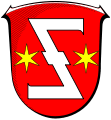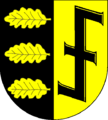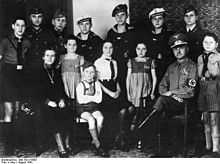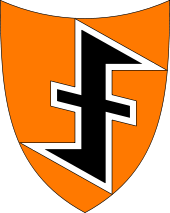Wolfsangel
.jpg) | |
| Reconstruction of a historical wolf trap, the original Wolfsangel |
The Wolfsangel (German pronunciation: [ˈvɔlfsˌʔaŋəl]) is a German heraldic charge inspired by an actual real historic wolf trap, consisting of two metal parts and a connecting chain. The top part of the trap, which resembled a crescent moon with a ring inside, used to be fastened between branches of a tree in the forest while the bottom part, on which meat scraps used to be hung, was a hook meant to be swallowed by a wolf. The simplified design based on the iron "wolf-hook" was often heavily stylized to no longer resemble a baited hook hung from a tree or an entire wolf trap. Other names included Wolfsanker ("wolf-anchor") or Wolfsjagd as well as hameçon or hameçon de loup, a half-moon shape with a ring, or as cramp or crampon in English with a ring at the center, sometimes also called Doppelhaken "double-hook", or acrampon with a transversal stroke. All of these symbols are still found in a number of municipal coats of arms in Germany. The crampon is also found as a mason's mark in medieval stonework.[1][2]
In early times, believed to possess magical powers, it became a symbol of liberty and independence after its adoption as an emblem of a peasant revolt in the 13th century against the oppression of the German princes and their mercenaries.[3]

Wolfsangel was an initial symbol of the Nazi Party.[4] In World War II the sign and its elements were used by various Nazi German storm divisions such as the Waffen-SS Division Das Reich and the Waffen-SS Division Landstorm Nederland.[4] In prewar Germany, Wolfsangel was partly inspired by the immense popularity of Hermann Löns's 1910 novel Der Wehrwolf during the 1930s, where the protagonist, a resistance fighter during the Thirty Years' War, adopted the magic symbol as his personal badge. The symbol itself bears a visual resemblance to the Eihwaz rune, historically part of the runic alphabet.[4]
Heraldry
The name Wolfsangel appears in a 1714 heraldic handbook, Wappenkunst, associated with a symbol distinct from the one now known under this name:
- Wolffs-Angel, frantz. hamecon, lat. uncus quo lupi capiuntur, ist die Form eines halben Mondes und hat inwendig in der Mitte einen Ring.
- "Wolffs-Angel, French hamecon, Latin uncus quo lupi capiuntur ("hook with which wolves are caught"), is the shape of a crescent moon with a ring inside, at mid-height"
The above quote, although, written for the Wolfsangel is referring to the Anchor (see below) for the Wolfsangel and not the Wolfsangel or "Wolf's-hook" proper.
In modern German-language heraldic terminology, the name Wolfsangel is de facto used for a variety of heraldic charges, including
- the hameçon described above, a half-moon shape with a ring (also called Wolfsanker and Wolfshaken).
- the cramp or crampon, a Z shape or double-hook symbol (also called Mauerhaken or Doppelhaken)
- a Z or double-hook symbol with a ring or transversal stroke at the center. It is only this symbol that also goes under the name "Wolfsangel" in the context of Neo-Nazism and occultism.
The crampon symbol is found comparatively frequently in municipal coats of arms in Germany, where it is often identified as "Wolfsangel". The "crampon with central stroke" design is more rare, but is still found in about a dozen contemporary municipal coats of arms. The French town of Wolfisheim, in the Alsace region of France has a "Wolfsangel" in its coat of arms.
-

A heraldic hameçon in the arms of the von Stein family.
-

A heraldic crampon in the municipal arms of Mannheim, Baden-Württemberg
-

Municipal arms of Erwitte, North Rhine-Westphalia
-

Municipal arms of Idar-Oberstein, Rhineland-Palatinate
-

Municipal arms of Marpingen, Saarland
-

Municipal arms of Oestrich-Winkel, Hesse
-

Municipal arms of Mommenheim, Rhineland-Palatinate
-

Municipal arms of Dassendorf, Schleswig-Holstein
-

Municipal arms of Ilvesheim, Baden-Württemberg
-

Municipal arms of Sibbesse, Lower Saxony
-

Municipal arms of Eppelborn, Saarland
-

Municipal arms of Burgwedel, Lower Saxony
-

Municipal arms of Kleinblittersdorf, Saarland
-

Municipal arms of Wedemark, Lower Saxony
-

Municipal arms of Wolfisheim, Bas-Rhin department
As boundary marker and "forestry symbol"

In a 1616 boundary treaty concluded between Hesse and Brunswick-Lüneburg was the Brunswick boundary marker called Wulffsangel. It was used not only on landmarks, but there is also evidence of its use in correspondence from the Forest Services in 1674.
Later the Wolfsangel was also used as a symbol on forest uniforms. In a document of 1792 regarding new uniforms, chief forester Adolf Friedrich von Stralenheim suggested a design for uniform buttons including the letters "GR" and a symbol similar to the Wolfsangel, which he called Forstzeichen.
Later the Wolfsangel was also worn as a single badge in brass caps on the service and on the buttons of the Hanoverian forest supervisor. In Brunswick it was prescribed for private forest and gamekeepers also as badge on the bonnet.[5]
The Wolfsangel is still used the various forest districts in Lower Saxony as a boundary marker, and it is part of the emblem of the state of Lower Saxony and the hunters' association Hirschmann, dedicated to the breeding and training of Hanover Hounds.
In literature
Der Wehrwolf
In 1910, Hermann Löns published a classic fiction book titled Der Wehrwolf (later published as Harm Wulf, a peasant chronicle and The Warwolf in English) set in a 17th-century German farming community during the Thirty Years' War. The main character of the book, Harm Wulf, adopts the wolfsangel as a badge against the occupying forces of the ruling princes. Some printings of this book, such as the 1940 edition, showcase a very visible wolfsangel on the book cover.It also features on his gravestone.
As a Nazi symbol



In Nazi Germany, the Wolfsangel was used by:
- the 2nd SS Panzer Division Das Reich
- the 4th SS Polizei Panzergrenadier Division
- the 34th SS Volunteer Grenadier Division Landstorm Nederland
- the Sturmabteilung "Feldherrnhalle" Wachstandart Kampfrunen (Assault Unit—SA--"Warlord's Hall" Guard Regiment
- the NS-Volkswohlfahrt organization
- the Nationaal-Socialistische Beweging NSB, Dutch Nazi fascist party
- the Werwolf plan of resistance against allied occupation was intended to use this symbol.[6]
Post-WWII
After World War II, the symbol was used by some Neo-Nazi organizations.
Public exhibition of the symbol is illegal in Germany if a connection with one of these groups is apparent.[7][8]
In USA extremist white supremacist Aryan Nations organization uses white Wolfsangel symbol with a sword replacing the cross-bar in its logo.[9]
In Ukraine it was used by SNPU (Social-National Party of Ukraine)[10][11][12] until 2004[13]and is currently used by Neo-Nazi Social-National Assembly[14] and Azov Battalion[13][15][16][17][18]
Also it is used by Church of Satan in horizontal form.[19]
See also
- Fascist symbolism
- Guido von List
- SS unit insignia
References
- ↑ Press release of the Regional Association of Westphalia-Lippe, 30 October 2009 No original ancient specimens of such hooks were known prior to 2009 when excavations at the Falkenburg ruin in Detmold yielded more than 25 wolf hooks dated to the 13th century. Video on YouTube
- ↑ Wolfsjagd - von Wolfseisen, Wolfsangel, Wolfsgruben & Wolfsankern.
- ↑ Lumsden, Robin (1993). The Allgemeine-SS. Osprey Publishing. p. 18. ISBN 9781855323582.
- ↑ 4.0 4.1 4.2 Lumsden, Robin (2009). Himmler's SS: Loyal to the Death's Head (GOOGLE BOOK, PREVIEW). The History Press. pp. 201–206. ISBN 0752497227. Retrieved 24 March 2015.
- ↑ Gerhard Große Löscher: Die Wolfsangel als Forst- und Jagdzeichen in Niedersachsen. In: Jürgen Delfs u. a.: Jagd in der Lüneburger Heide. Beiträge zur Jagdgeschichte. Celle 2006, ISBN 3-925902-59-7, 238–239
- ↑ Watt, Roderick (October 1992). "Wehrwolf or Werwolf? Literature, Legend, or Lexical Error into Nazi Propaganda?". The Modern Language Review 87 (4).
A study of the iconography of German nationalist groups between the wars and then of Nazi party, military, and paramilitary organizations from 1933 to 1945 proves beyond doubt that the 'Wolfsangel' symbol was widely, even indiscriminately used by them long before the formation of the Nazi Werwolf movement at the end of the war. Wolfsangel, if at all translatable, means, or at least originally meant, 'wolf trap', an instrument which is a threat to the wolf. Yet both Lons and the Nazis used it as a menacing symbol of intimidation representing the savage and relentless ferocity of the wolf… In the late summer or early autumn of I944, when it was clear that Germany was committed to a European land war on two fronts, Reichsführer-SS Heinrich Himmler initiated Unternehmen Werwolf, ordering SS-Obergruppenführer Prutzmann to begin organizing an elite troop of volunteer special forces to operate secretly behind enemy lines.
- ↑ "In Deutschland verbotene Zeichen und Symbole". Informations- und Dokumentationszentrum für Antirassismusarbeit in Nordrhein-Westfalen.
- ↑ "Gruppierungen auf dem Index". Programm Polizeiliche Kriminalprävention.
- ↑ Aryan Nations
- ↑ Andreas Umland. Kyiv’s Next Image Problem
- ↑ Analysing Fascist Discourse: European Fascism in Talk and Text,Per Anders Rudling “The Return of the Ukrainian Far Right: The Case of VO Svoboda" edited by Ruth Wodak, John E. Richardson. Routledge, 2012
- ↑ Olszański, Tadeusz A. (4 July 2011). "Svoboda Party – The New Phenomenon on the Ukrainian Right-Wing Scene". Centre for Eastern Studies. OSW Commentary (56)
- ↑ 13.0 13.1 Richard Sakwa. Frontline Ukraine: Crisis in the Borderlands pages 21,158
- ↑ Anton Shekhovtsov. Provoking the Euromaidan
- ↑ Anton Shekhovtsov. Look far right, and look right again
- ↑ http://foreignpolicy.com/2014/08/30/preparing-for-war-with-ukraines-fascist-defenders-of-freedom/
- ↑ http://www.nytimes.com/2014/12/14/world/europe/a-pastors-turn-fighting-for-ukraine.html?_r=0
- ↑ http://www.telegraph.co.uk/news/worldnews/europe/ukraine/11025137/Ukraine-crisis-the-neo-Nazi-brigade-fighting-pro-Russian-separatists.html The Telegraph Ukraine crisis: the neo-Nazi brigade fighting pro-Russian separatists
- ↑ Chris Mathews. Modern Satanism: Anatomy of a Radical Subculture, p.110
Sources
- K. von Alberti, Die sogenannte Wolfsangel in der Heraldik, Südwestdeutsche Blätter für Familien und Wappenkunde 1960, p. 89.
- H. Horstmann, Die Wolfsangel als Jagdgerät und Wappenbild, Vj. Bl. d. Trierer Gesellschaft für nützliche Forschungen, 1955.
External links
| Wikimedia Commons has media related to Wolfsangel. |
| Wikimedia Commons has media related to Cramps in heraldry. |